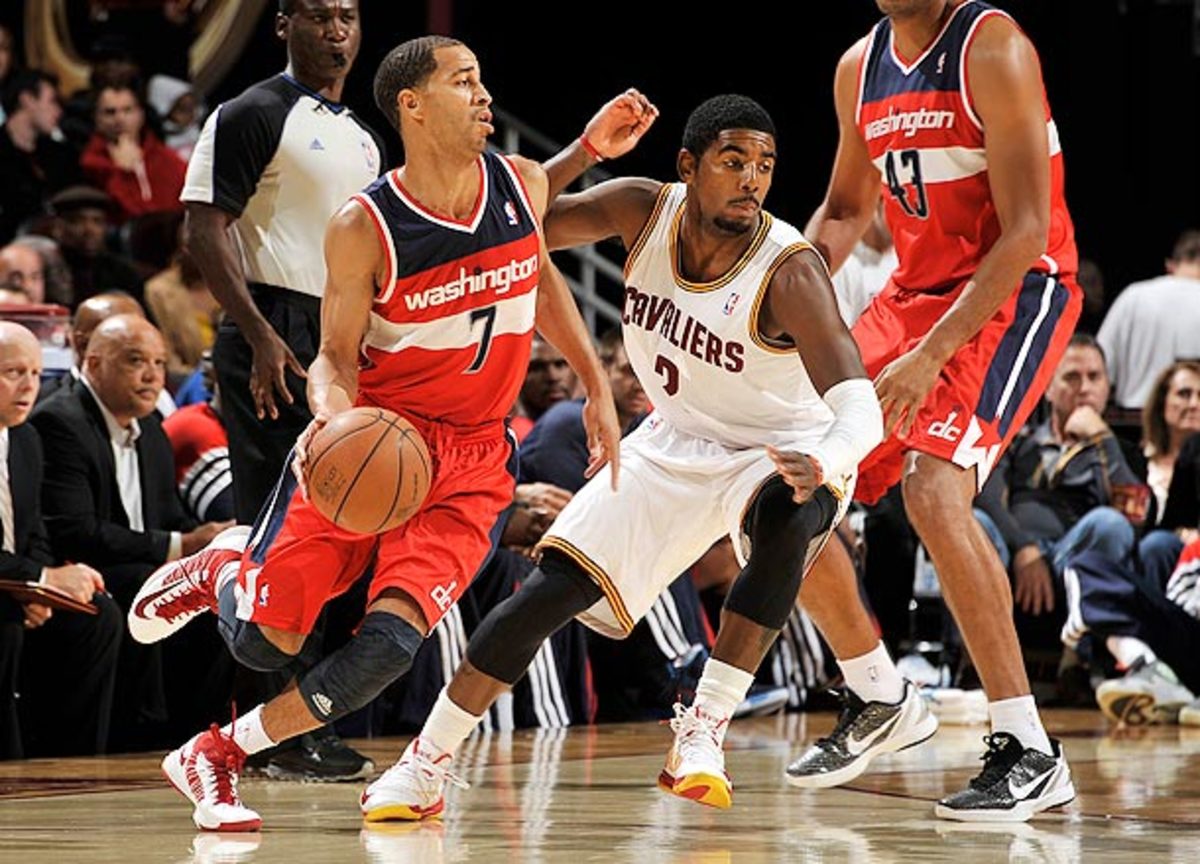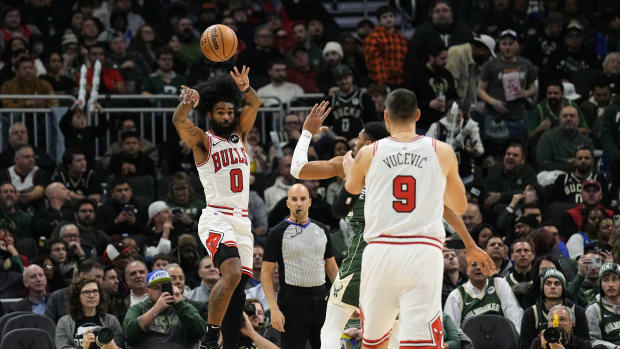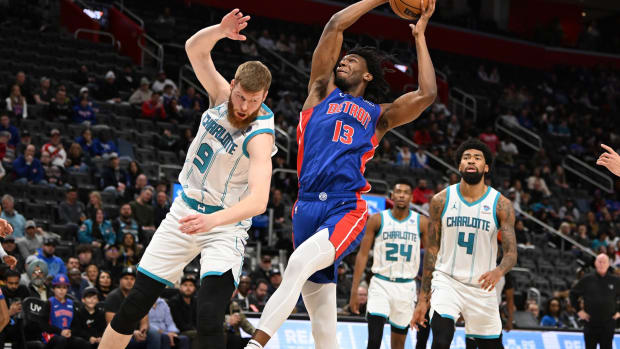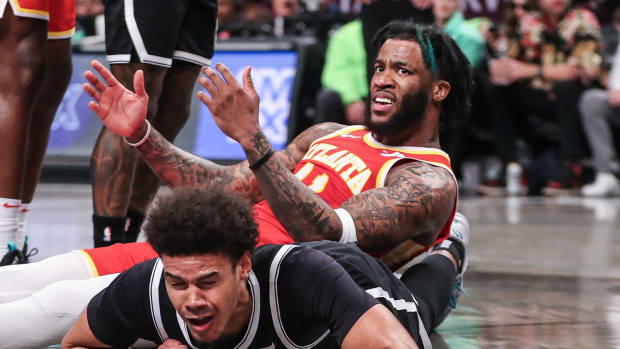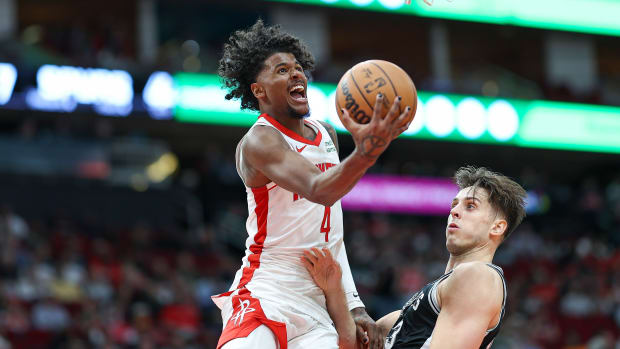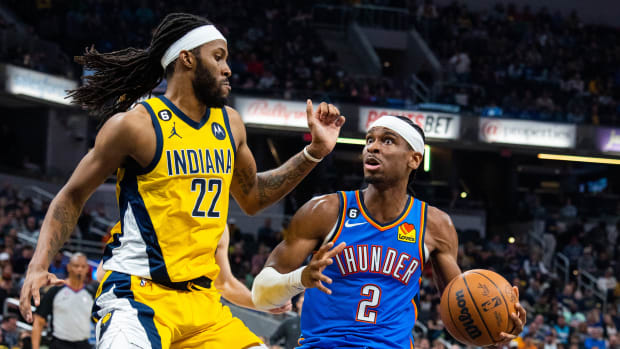Isolating the 'missing ingredient' that can propel players to the next level
Subpar athleticism greatly hinders Kyrie Irving (middle) on the defensive end. (David Liam Kyle/NBAE via Getty Images)
By Rob Mahoney
The NBA may boast the most impressive collection of basketball talent on the planet, but each and every one of the league's players -- from superstars to role players to training camp hopefuls -- is a work in progress. All hope to build on some facet or another, and most spend countless hours in the gym hardening the technical aspects of their game and scrimmaging to reinforce situational judgment.
Today we take a look at what's missing for a select group of players, and what's next in their developmental path. Some may need to build on a strength and others rectify a weakness. But put simply: What is it -- whether fixable or innate -- that prevents a certain NBA player from rising into the next stage of his basketball evolution?
Kevin Durant, Oklahoma City Thunder
Missing ingredient: Help defense
Durant's game isn't just impressive; it's impressively complete. He scores, he boards and he passes better than many think. Plus, with significant improvements in both on-ball defense and ball handling over the last few seasons, Durant has managed to expand his already tremendous utility.
But one area of improvement that remains -- and one of the key points of separation between Durant and LeBron James -- is the ability to extend his defensive impact beyond a single opponent. Even in his best defensive moments, Durant is merely a good, versatile deterrent. His footwork and lateral movement allow him to stay in front of opponents well, and his length affords him the opportunity to contest shots without jumping or fouling. James, on the other hand, has taken his unique athletic profile to different heights entirely and created a new defensive precedent for hyper-athletic wing players.
Durant may not share in all of James' incredible physical gifts, but his size and speed provide enough overlap that he should be able to exert some of the same off-ball pressure. That would require Thunder coach Scott Brooks to release Durant from more conventional defensive duties in order to swarm ball-handlers, jump passing lanes and close up paths to the basket. The latent potential here is too great to ignore.
Avery Bradley, Boston Celtics
Missing ingredient: Refined offensive off-ball skills
When a smaller guard enters the league without much innate playmaking skill, the natural compulsion of coaches is to begin a point guard education of sorts. We've seen savvy backcourt scorers shoved into uncomfortable roles that are literally unbecoming; one cannot will a player into being an orchestrator of an offense, and often these attempted conversions only leave talented prospects lost between positions or deflated by the experience.
Luckily, Boston coach Doc Rivers knows better than to put Bradley through that tired machine, and he has the luxury of using the third-year guard in an entirely different capacity thanks to the passing of Rajon Rondo, Paul Pierce and Kevin Garnett. Bradley can handle the ball a bit, but he hasn't shown much aptitude in initiating the offense. Where he does show offensive promise, however, are in the court's gray areas; Bradley has an impressive awareness of cutting and spacing at just 22 years old, and he could become an incredibly valuable off-ball player if he continues to work on that aspect of his game.
Simply having Courtney Lee and Jason Terry in Boston should provide an invaluable learning experience. Not only are both trained in the catch-and-shoot arts (an area of Bradley's game that could definitely use some work), but Lee shares Bradley's knack for cutting through the back door and Terry excels at so many of the little things that come in working without the ball. With those two mentors in town, and Bradley a sponge for basketball insight, I'd be shocked if we don't see an acceleration in the young Celtic's offensive development.
Tyler Hansbrough finished with zero assists a whopping 42 times last year. (Fernando Medina/NBAE via Getty Images)
Tyler Hansbrough, Indiana Pacers
Missing ingredient: Passing
I am forever in awe of Hansbrough's steadfast commitment to not passing. In 66 regular-season games last year, Hansbrough posted two assists (his season high) just six times. He finished with zero assists a whopping 42 times. It's as if the notion of making a productive pass had never truly occurred to him -- that somewhere within his very biological wiring was a lonely series of scoring options, unbothered by even the possibility of making a play for the sake of another player.
Hansbrough isn't selfish so much as intently focused; he executes his instinctive mandates with a heightened intensity and functions solely as the end-all of a given offensive possession. But that doesn't mean he (and the Pacers) couldn't benefit from a kick-out pass here and there, particularly when Hansbrough often surrenders a size advantage inside. That kind of radical shift in approach isn't likely to occur anytime soon, but if Hansbrough were able to add only the occasional dish to his otherwise productive game, he'd instantly become a more valuable asset in a team context.
Kyrie Irving, Cleveland Cavaliers
Missing ingredient: Defense
When Irving has the ball in his hands, he plays the game as if he knows something his defender doesn't. He has full control -- of the offense, the situation and the ball itself -- at all times and understands how to manipulate defenders in order to eke out open looks. Every feint or fake is done with a smirk, as Irving lures his opponent into ill-advised gambles or concessions of angles.
That level of offensive mastery does a spectacular job of hiding the fact that Irving, for all of his many gifts, simply isn't a standout athlete. He's quick enough to make a living by working off the dribble, but he doesn't explode around screens at the velocity of Russell Westbrook or Derrick Rose. He's not terribly quick -- simply quick enough.
That tends to create problems for Irving on the defensive end, where he's starting to become a bit of a liability. Everything is an issue at this point; effort (Irving tends to lull around screens), instincts (a misstep on the perimeter throws Irving out of position rather quickly) and a lack of a dependable system (three cheers for rebuilding) are all tied to Irving's defensive struggles, and they sandbag his overall value as a player as a result. Much of that can be rectified with both individual and team growth, but for now, Irving can do his part by at least working throughout entire defensive possessions.
Michael Beasley, Phoenix Suns
Missing ingredient: Deference to the offense
The problem with Beasley has never been his shooting volume, per se, but where (and when) his shots come within the offense. At this stage in his career, Beasley is an epitomic ball-stopper, and he's far too content to derail primary and secondary offensive options for the sake of an early look. Blame his life as a prep star, confidence in his own scoring abilities or lack of self-control, but nipping that tendency is the surest way to elevate Beasley into the ranks of more productive offensive players. That, in a nutshell, is what makes a player like Beasley so frustrating. He certainly has other flaws and limitations, but all that bars Beasley from life as a scoring dynamo is the simple knowledge of when not to shoot.
Jeff Teague, Atlanta Hawks
Missing ingredient: Versatility
A lot of fans are very high on Jeff Teague, but at this stage he is almost exclusively a pick-and-roll scorer. Outside of that single scenario, Teague often struggles to create open looks for himself without the aid of a screen, and doesn't yet make passing reads beyond hitting an immediate, wide-open teammate.
That pick-and-roll effectiveness is a terrific foundation, and this season -- during which Teague will assume a greater offensive responsibility after Joe Johnson's departure -- should be a great opportunity to see what else Teague might have up his sleeve. Screen-less shot creation, playmaking sophistication and on-ball defense are all on Teague's to-do list, and those are elements of his game worth watching as the Hawks move into a new era.
Omer Asik is simply a dreadful catch-and-finish player around the rim. (Chris Graythen/Getty Images)
Omer Asik, Houston Rockets
Missing ingredient: Hands
Asik did a phenomenal job of extending Tom Thibodeau's defensive philosophy in Chicago, but the concerns over his zero-sum potential are perfectly legitimate. For every stellar rotation is a bobbled catch on the other end, and for every halted drive is an instance of the opposing defense tilting away from the harmless Asik. Offensive rebounding (on top of absolutely tremendous defensive play) certainly helps to tip the scales in Asik's favor, but there's no way around the fact that the 26-year-old center is simply a dreadful catch-and-finish player around the rim.
Let me clarify: It's not the finishing that troubles Asik. He doesn't exactly have a soft touch or an array of hooks and reverses, but Asik typically fares well enough with two-handed dunks and the like. He just has a terribly difficult time corralling passes on the move and tends to get stripped going up toward the rim. Those are pretty important phases of the game for a mobile 7-footer with no post game to speak of. For now, Asik lacks the grip and grab to be anything more than a defensive centerpiece.
Kawhi Leonard, San Antonio Spurs
Missing ingredient: Shot creation
As a great positional rebounder, a promising defender and an emerging three-point threat from the corners, Leonard seems tailor-made for the Spurs. But let's not forget: These Spurs aren't quite what they used to be, and Gregg Popovich will be counting on Leonard -- among others -- to help make up for some of the age-related decline among San Antonio's stars.






























